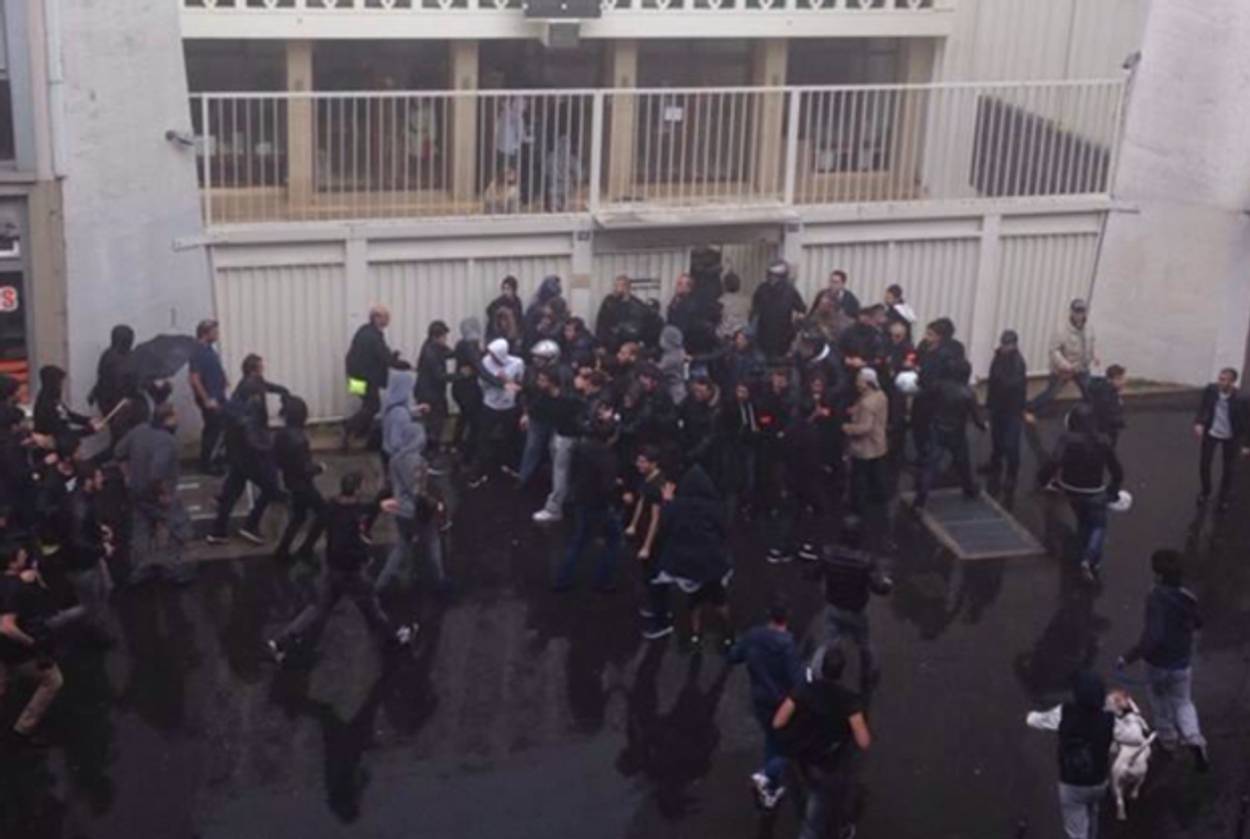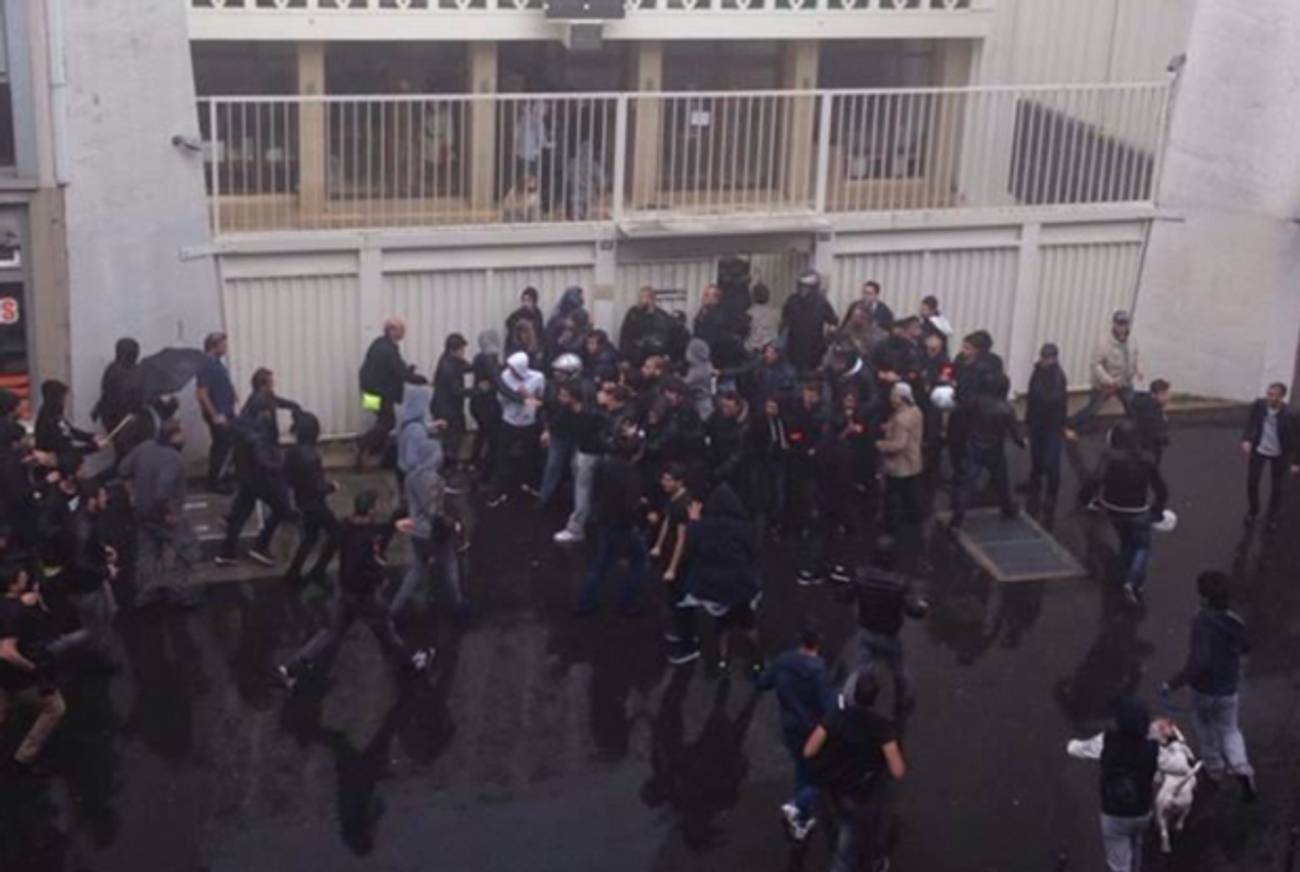The Guardian Debunks Paris Synagogue Siege Skeptics
What really happened at the Don Isaac Abravanel synagogue in July




On July 13, 2014, the Associated Press reported that “Pro-Palestinian protesters tried to force their way into a Paris synagogue Sunday with bats and chairs, then fought with security officers who blocked their way.” The article cited both eyewitnesses and police. “A police spokeswoman said the Don Isaac Abravanel synagogue in eastern Paris was targeted during a service, and worshippers were blocked inside while police pushed protesters back,” the piece continued. “Aline Le Bail-Kremer watched the incident unfold from her window across the street. She said protesters came from two directions and converged on the synagogue, grabbing chairs from sidewalk cafes and wielding bats as they tried to push past security guards.” Video footage soon emerged showing members of the French Jewish Defense League fending off the attackers.
As one would expect, this incident was reported as an anti-Semitic attack by many journalists on the ground–including the New York Times, which noted that the mob chanted “Death to Jews”–and was described as such by France’s Prime Minister. Yet in some corners of the media, particularly online, skeptics insisted that the entire incident had been fabricated for propaganda purposes. These critics recast the JDL who repelled the mob as instigators who provoked the entire affair, or at least misrepresented a street fight as an anti-Semitic attack. And to make their case, the skeptics cited a seemingly unimpeachable source: the synagogue’s own president, Serge Benhaim, who allegedly told an interviewer that no substantive assault had taken place. But as a recent Guardian investigation reveals, that interview has been dramatically misrepresented–and in fact states the opposite.
In a thoughtful piece titled “The Threat to France’s Jews” that is worth reading in full, Natasha Lehrer explains how agenda-driven writers distorted Benhaim’s words to help them minimize the incident’s anti-Semitic character. Lehrer first records more eyewitness testimony as to what actually transpired:
Bernard Abouaf, a journalist for the left-leaning Radio Shalom, was with friends nearby when he received a call on his mobile that the synagogue was being attacked. He rushed to the scene. “There were a hundred or so pro-Palestinian activists rushing towards the synagogue. There were 40 Jews outside defending the 160 people who were trapped inside. Let me tell you, I have never in my life defended the JDL [Jewish Defense League],” he said. “But that evening, if they hadn’t been there, the synagogue would have been destroyed, with all the people trapped inside.”
Lehrer then tackles the purported denial of these events by the synagogue’s president:
Abouaf insisted that I sit with him to watch a video that had spread widely after the incident, under a headline announcing that Serge Benhaim – the president of the synagogue – denied any attack had taken place. The video shows a young journalist, Julien Nény, repeatedly asserting in an interview with Benhaim that the violence had been instigated by the notorious Jewish Defence League; his questions to Benhaim focus on the reputation of the JDL for violence rather than on the events of the afternoon. Under Nény’s insistent questioning, the quietly spoken Benhaim repeats that “that version of events is wrong” Eventually, the spooling, repetitive question-and-answer becomes hard to follow. It was only after watching the video four times that I understood: Benhaim is repeatedly denying, in the same phrase, Nény’s repeated suggestion that the violence had been provoked by the JDL. His endlessly looping denial ends up being twisted by Nény’s bullying persistence into the opposite of what he is saying – it sounds as though he is denying that the synagogue was attacked. It’s an impressive journalistic sleight of hand, so successful, indeed, that it made its way round the world, written about by journalists who may have simply read the headline and not even bothered to watch the video – evidence, perhaps, of a surprisingly widespread taste for the notion that antisemitic violence is a chimera, faked by Jews and supported by the government as part of a strategy to demonise Muslims in France and elsewhere.
Credit is due to Lehrer and The Guardian for unmasking this deception, and to the AP, New York Times, and local police and political officials for being willing to face this anti-Semitism, rather than attempt to obscure it. If there is to be a brighter future for Jews in France, it will start with recognizing the hate they face, and calling it by its proper name.
Yair Rosenberg is a senior writer at Tablet. Subscribe to his newsletter, listen to his music, and follow him on Twitter and Facebook.